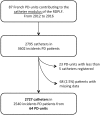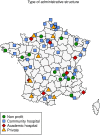Patterns of peritoneal dialysis catheter practices and technique failure in peritoneal dialysis: A nationwide cohort study
- PMID: 31220171
- PMCID: PMC6586404
- DOI: 10.1371/journal.pone.0218677
Patterns of peritoneal dialysis catheter practices and technique failure in peritoneal dialysis: A nationwide cohort study
Abstract
Introduction: Our objective was to assess whether clusters of centers with similar peritoneal dialysis (PD) catheter related practices were associated with differences in the risk of technique failure.
Methods: Patients on incident PD in French centers contributing to the French Language PD Registry from 2012 to 2016 were included in a retrospective analysis of prospectively collected data. Centers with similar catheter cares practices were gathered in clusters in a hierarchical analysis. Clusters of centers associated with technique failure were evaluated using Cox and Fine and Gray models. A mixed effect Cox model was used to assess the influence of a center effect, as explained by the clusters.
Results: Data from 2727 catheters placed in 64 centers in France were analyzed. Five clusters of centers were identified. After adjustment for patient-level characteristics, the fourth cluster was associated with a lower risk of technique failure (cause specific-HR 0.70, 95%CI 0.54-0.90. The variance of the center effect decreased by 5% after adjusting for patient characteristics and by 26% after adjusting for patient characteristics and clusters of centers in the mixed effect Cox model. Favorable outcomes were observed in clusters with a greater proportion of community hospitals, where catheters were placed via open surgery, first dressing done 6 to 15 days after catheter placement, and local prophylactic antibiotics was applied on exit-site.
Conclusion: Several patterns of PD catheter related practices have been identified in France, associated with differences in the risk of technique failure. Combinations of favorable practices are suggested in this study.
Conflict of interest statement
The authors have declared that no competing interests exist.
Figures






Similar articles
-
Clusters of Practice in Peritoneal Dialysis in France: Data from the Catheter Section of the RDPLF.Perit Dial Int. 2018 Mar-Apr;38(2):89-97. doi: 10.3747/pdi.2017.00135. Epub 2017 Nov 21. Perit Dial Int. 2018. PMID: 29162681
-
Quantifying the risk of insertion-related peritoneal dialysis catheter complications following laparoscopic placement: Results from the North American PD Catheter Registry.Perit Dial Int. 2020 Mar;40(2):185-192. doi: 10.1177/0896860819893813. Epub 2020 Jan 17. Perit Dial Int. 2020. PMID: 32063191
-
Center Effects and Peritoneal Dialysis Peritonitis Outcomes: Analysis of a National Registry.Am J Kidney Dis. 2018 Jun;71(6):814-821. doi: 10.1053/j.ajkd.2017.10.017. Epub 2017 Dec 28. Am J Kidney Dis. 2018. PMID: 29289475
-
Peritoneal catheters and exit-site practices toward optimum peritoneal access: a review of current developments.Perit Dial Int. 2005 Mar-Apr;25(2):132-9. Perit Dial Int. 2005. PMID: 15796138 Review.
-
Percutaneous versus surgical insertion of PD catheters in dialysis patients: a meta-analysis.J Vasc Access. 2015 Nov-Dec;16(6):498-505. doi: 10.5301/jva.5000439. Epub 2015 Jun 29. J Vasc Access. 2015. PMID: 26165817 Review.
Cited by
-
Optimizing peritoneal dialysis catheter placement.Front Nephrol. 2023 Apr 11;3:1056574. doi: 10.3389/fneph.2023.1056574. eCollection 2023. Front Nephrol. 2023. PMID: 37675363 Free PMC article. Review.
-
Transitions between dialysis modalities.J Nephrol. 2022 Dec;35(9):2411-2415. doi: 10.1007/s40620-022-01397-8. Epub 2022 Jul 18. J Nephrol. 2022. PMID: 35849263
-
Catheter Event Rates in Medical Compared to Surgical Peritoneal Dialysis Catheter Insertion.Kidney Int Rep. 2023 Sep 17;8(12):2635-2645. doi: 10.1016/j.ekir.2023.09.015. eCollection 2023 Dec. Kidney Int Rep. 2023. PMID: 38106573 Free PMC article.
-
Changes in serum albumin concentrations during transition to dialysis and subsequent risk of peritonitis after peritoneal dialysis initiation: a retrospective cohort study.J Nephrol. 2020 Dec;33(6):1275-1287. doi: 10.1007/s40620-020-00716-1. Epub 2020 Mar 4. J Nephrol. 2020. PMID: 32130719
-
Comparative Effectiveness of Local Application of Chlorhexidine Gluconate, Mupirocin Ointment, and Normal Saline for the Prevention of Peritoneal Dialysis-related Infections (COSMO-PD Trial): a multicenter randomized, double-blind, controlled protocol.Trials. 2019 Dec 19;20(1):754. doi: 10.1186/s13063-019-3953-8. Trials. 2019. PMID: 31856900 Free PMC article.
References
-
- Davenport A. Peritonitis remains the major clinical complication of peritoneal dialysis: the London, UK, peritonitis audit 2002–2003. Perit Dial Int 29:297–302, 2009. - PubMed
-
- See ES, Johnson DW, Hawley CM, Pascoe EM, Darssan D, Clayton PA et al. Early peritonitis and its outcome in incident peritoneal dialysis patients. Perit Dial Int 2018. [in press] - PubMed
MeSH terms
LinkOut - more resources
Full Text Sources
Molecular Biology Databases

